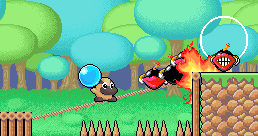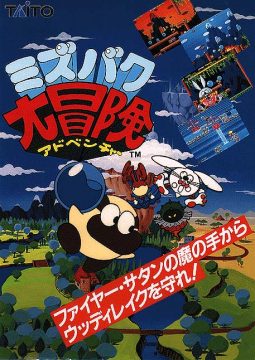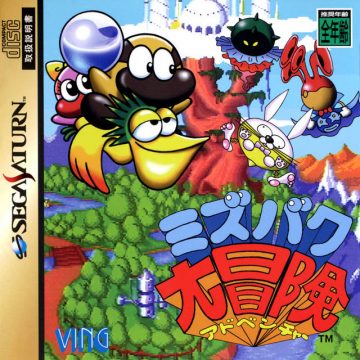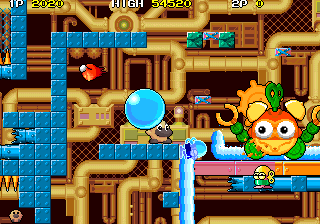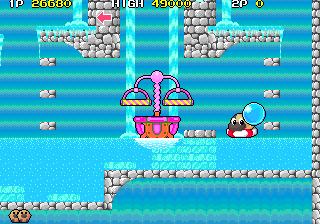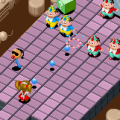Liquid Kids, also known as Mizubaku Daibouken (“Water Bomb Big Adventure”), is one of Taito’s many cutesy platform games. It never received the same recognition and appreciation as Bubble Bobble, but it still shows their ability in creating an appealing title for all ages.
The star of the game is Hipopo, a cartoon platypus thing, who lives with his girlfriend Tamasun and other critters in the peaceful Woody Lake. The clownish Fire Demon invades and captures nearly everyone, except for Hipopo, who is armed with a magical artifact that arms him with water bombs.
The story shares a lot with Taito’s previous arcade platformer, The NewZealand Story, right down to the caged animals that are rescued at the end of each stage. The connections go deeper than the plot, as this game also shares the enemies’ habit to pour out of portals that pop out of nowhere, as well as secret warps can be found by hitting particular spaces with the weapon. These details and others, like the games sharing the same interface font, has brought many to consider Liquid Kids a spiritual successor to The NewZealand Story, which never received a real sequel (the subpar Nintendo DS remake can be ignored).
Luckily for Hipopo, the levels are much more straightforward than the ones of The NewZealand Story, and in general, the game’s approach is much mellower and less frantic. It’s also quite a bit easier, but later stages have all the usual platformer challenges, such as spikes, crumbling floors, traps, and overwhelming floods of enemies.
One factor for this change of pace is Hipopo’s weapon, water bombs, which aren’t nearly as quick and precise as Tiki’s arrows and laser beams. The water bombs travel in an arc, bounce, and then explode in a water stream. If it touches any enemies, they won’t be killed but rather frozen in place temporarily, allowing Hipopo to push them against walls, or each other to create big score chains. (Five or more enemies in a row gives you a random special bonus). Basically, the bombs are a cross between Bubble Bobble‘s water bubbles and the snowballs from Snow Bros., a single screen platformer by Toaplan that was released in the same year.
Water bombs are more versatile than usual platforming game weapons, since they are used for various purposes such as putting out fires, making plants grow so they can be used as platforms, making some watermills and similar contraptions move, and so on. They also need to be charged by keeping the button pressed – if you mash it, Hipopo will shoot smaller and smaller bombs and also at a diminishing rate. Our hero needs to get water-related items such as buckets, pumps and water guns to improve the bombs’ range, rate and dimension, again much like Snow Bros‘ snowballs. It’s pretty much imperative, since they are the only weapon you will ever get.
Another reason for the game’s relaxed pace is Hipopo’s speed, which is unfortunately very slow and even slower when you swim on water. He can get faster by picking up the train icon (and not the boots icon, which, unlike every other game, prevents Hipopo from getting dragged by watery platforms and his own water streams), but this is counter-balanced by the piggy icons which, other than giving 1000 points, only reduces walking speed further. Also, whenever you lose a life, your speed and weapon status are reset, making Hipopo an easy target. This is an issue during battles with bosses, who can pull some mean tricks when about to be defeated. However taking too many speed-up bonuses in a row can make Hipopo harder to control, so sometimes piggies are needed to keep his speed in check.
Every time you beat a boss, two doors open and you have to choose a branching path after every stage. One of these takes Hipopo to a harder first stage of the next area, but it’s just for those who want a greater challenge, since there’s no better reward for beating them. Usually the harder path is on the right, but that gets reversed for the final stage, making for an especially nasty surprise if someone assumes that the paths remain consistent.
The graphics are pretty good and help convey the cutesy, relaxed feeling of the title. The settings are mostly typical of other platformers from the 90s, including a factory full of hazards, an Egyptian stage with many tricks and traps, and the evil dark castle at the end, all drawn in a fairy tale style, but without the surrealism and “anything goes” quality that The NewZealand Story had, going for more internal consistency.
A cool effect is the changing from morning to dusk in the stages set outside, with the palette darkening to represent the passage of time, a very nice visual that gets comically sped up if you happen to find a warp that brings you directly to the boss’ lair.
Hipopo and his enemies are typically cute, rotund Taito creations, short on animation frames but rich in personality. Special mention goes to the goofy end-stage bosses including the final one, a demon that looks like a wizard clown. Several enemies, being the Fire Devil’s minions, are related to fire, such as living bombs and flying Venus flytraps that spit fire, but the majority is just random creatures not always related to the theme of the level, including splitting amoebas and mechanical ducks that swallow your water bombs. The folks to be rescued are far more varied than the kiwis from The NewZealand Story, and range from kids to old men, from hicks to nobles. Even the time-out enemy, who chases you if you dawdle, is bizarre – a green-haired clown in a checkered dress with a scythe.
One amusing thing is how often Hipopo is played for a fool. The intro sequence has a random image of him selected from his dying animations (crushed, electrocuted, burned…), one intermission has him find Tamasun only for her being replaced with an enemy without him even noticing, and the continue screen countdown has the seconds ticking in unison with a bomb enemy bouncing on Hipopo’s head, who then explodes when the screen fades to black if you don’t insert any credits. It’s a strange way to inject some personality into him, but it’s still endearing.
In the end, Liquid Kids is another example of Taito’s mastery in the platform game genre. Maybe it’s a bit by-the-books, without some memorable inventions, and the water bombs are a bit cumbersome for a weapon, but it’s still fun, engaging, pleasant to the eyes and ears, and carefully constructed for newbies and experts alike.
Unlike Taito’s earlier platformers, Liquid Kids did not receive the same plethora of ports. Around the time of its release, only one was produced, for PC Engine in 1992. Unlike the mediocre port of The NewZealand Story for the platform, it resembles closely the arcade original. Sure, the effect of time passing was removed, and there are simpler backgrounds without parallax, but the stages are nearly identical, the physics of the water bombs have been faithfully represented, and the warps are all there, with some nice little additions such as an homage to Tiki the kiwi. The tunes are also very similar to arcade, accounting for platform’s lesser sound hardware (the boss theme sounds like it came out of DuckTales for the NES, not that this would be a bad thing). There is no intro cinematic but brief cutscenes at the beginning of every level showing Hipopo following some enemies from that level.
There is one blatant difference though: you’re only offered branching paths in the even-numbered levels, while the others only have one choice, the easier one of the two. In general, the game has been made easier, with enemies that go down in fewer hits and are less aggressive. For example, the rock golems in the pyramid no longer throw their boulders in an arc but straight ahead, thus much easier to avoid. The bosses, however, have been made tougher, simply by having the battles restart from scratch if you lose them. This is aggravating in the case of bosses who have more than one form (the fourth and the final one, who, unsurprisingly, are the hardest ones).
Eight years after the game appeared in the arcades, a perfect port was made for the Sega Saturn by Ving, the same company that handled the port of The NewZealand Story on the FM Towns. The game was also part of 2006’s Taito Legends 2 for PlayStation 2, XBOX and Windows, which is an emulation of the arcade version. Like all of the others on the collection, the visuals are a little blurry but otherwise it’s great.
In 2003, however, the Amiga community suddenly discovered that Liquid Kids had been converted for the system, only it was never officially released and was buried into their developers’ hard disks. The French branch of Ocean Software, founded in 1986 and responsible for some pretty good coin-op conversions, such as Operation Wolf and Dragon Ninja, planned in 1991 to make conversions of Taito games, but Ocean UK never was able to secure the rights of those.
So Liquid Kids for Amiga had been finished but nobody knew about it, until a member of the English Amiga Board forum was able to contact the developers and arranged for the title to be released. (Curiously, the only other finished but unreleased game by Ocean France was Snow Bros. It seems that these two titles have to be related somehow…) As for the port itself, the graphics are decent, the music is completely different, and the fifth level (the giant tree area) is missing, but all in all it’s a very good conversion, with a few bugs (nothing game-breaking though) and some added touches, like a score boost at the end of every stage related to the number of point bonuses collected.
Links:
The Brothers Duomazov Review of Liquid Kids for PC Engine, once again comparing it to The NewZealand Story.
Codetapper’s Amiga Retro Site Interview with Marc Djan of Ocean France about the unreleased Amiga games.
English Amiga Board The page of the EAB thread where the discovery of Liquid Kids Amiga is detailed.

